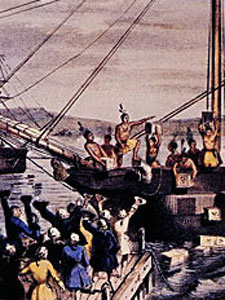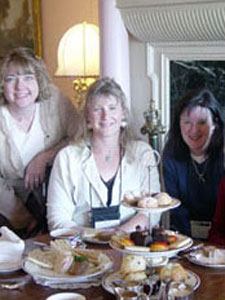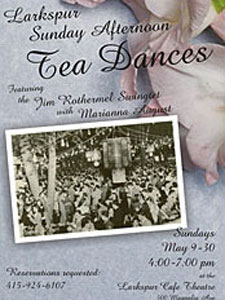The Tea Party: History and Ideas



It was early on the crisp December evening. A group of two hundred some-odd men assembled in disguise on a nearby hill. The crowd marched down to the wharf two-by-two, crying, "Boston harbor, a teapot tonight!"
They descended upon three ships and demanded the captains grant them access to the holds. With the faux-tomahawks from their costumes, they split open all 340 chests of cargo and pitched them overboard. This single event, organized as a protest against a tax that made it harder to get tea, was dubbed "The Boston Tea Party."
Though this may be the most famous tea party in history, the idea of a tea party is not only still alive, but very popular today. In this installment of TeaMuse, we'll move away from Boston Harbor and explore the interesting history of the tea party, as well as suggest some contemporary ideas to infuse into your next festiviTEA.
Before we begin, we must ask this most important question: "What is a tea party?" At its most basic, a tea party is nothing more than a gathering of people where the primary focus is on the tea. Often referred to simply as "tea," different varieties of tea parties include children's tea, wedding tea, afternoon tea, high tea, tennis tea, tea dances and many more.
Utilizing this loose definition of a tea party mentioned above, one could suggest that tea parties have been going on since the discovery of tea itself. The Gong Fu (or "Kung Fu") tea ceremony has been practiced in China for hundreds of years, and involves the host and guests practicing "great skills and patience." Chanoyu, a similar (but much more regimented) Japanese ritual, was first introduced over five hundred years ago.
However, for most Westerners, a "tea party" refers to the British custom. It was the British (or to be more precise, Anna, the seventh duchess of Bedford), who introduced the famous practice of "afternoon tea" to the Western world in the early 1800s. At that time, the English only ate two main meals a day—a hearty breakfast and enormous dinner. Somewhere in between these meals, Anna experienced a "sinking feeling" and so began to prepare small snacks accompanied by tea. The practice of inviting friends to come for tea in the afternoon was quickly picked up by other upper-class social hostesses.
Afternoon tea is often confused with High tea, but there are some rather important differences. First, while "high tea" sounds like an event for the elite, is was originally created by the working class rather than the upper-class. Second, Afternoon tea is, obviously, taken in the afternoon, while High tea is more of an evening event. During the Industrial Revolution, working families would come home around 6pm for dinner. Meat, bread and butter, cheese, pickles and, of course, tea would usually be served (not the dainty finger sandwiches, scones and pastries of Afternoon tea). The moniker "High Tea" actually arose due to the fact that it was eaten at a high, dining table rather than the low tea tables.
By the middle of the 19th century in England, tea was all the rage. Tea parties and events were organized for all different social classes and ages. London's Pleasure Gardens began to host "tea dances," light-hearted events that whiled away the tea hour with subdued dancing. That is, until the importation of the Tango from Argentina. Hemlines were raised and inhibitions were released... Unquestionably, the Tea Tango was one of the hottest tea parties in history.
The tea party, after fostering the enjoyment of gourmet tea for years, soon began to decline with the implementation of the teabag into daily life. The taking of tea was transformed from an elegant, social practice into a convenient, individual process. However, with the rise of popularity in gourmet tea, there has also been a renaissance of the tea party. With hundreds of tearooms opening each year (check out TeaMap.com, for details!), traditional tea parties are once again becoming common, synthesizing with popular culture to create interesting new tea trends.
One of the most common queries I get as a Tea Maestro is, "which teas do you recommend I serve at my upcoming tea party?" Personally, when I'm having tea with friends, I like something familiar as well as something unique. In other words, I'd recommend a blend of tradition and novelty. Because many of the tea party's guests many not be Maestros, it is always a good idea to offer some "classic" teas, such as English Breakfast, Darjeeling or Earl Grey. But be sure to also include some exotic teas that they may not have experienced, such as Jasmine Pearls, Genmaicha and Silver Needle.
Found in the recipe for almost all successful endeavors, the main ingredients in a successful tea party are creativity and quality. Choose the best teas you can afford and enjoy them in a way that is unique to you and your guests. Bottoms up, tea tangoers!
